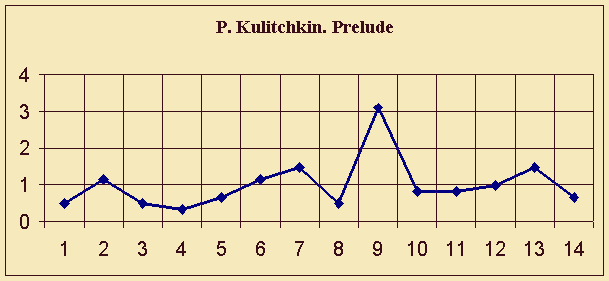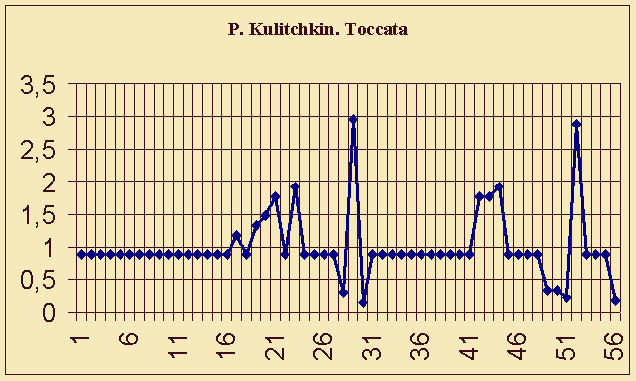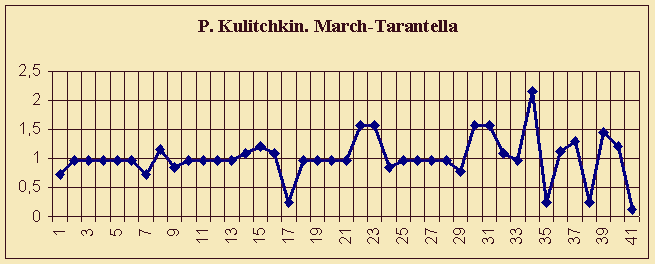About the research of one's own work
Introduction
A
practicing composer's mere study of musical psychology and theory is always
controversial: a theory implies that certain objective laws should be
established, whose value is directly related to their universality as applied
to any sort of practice. While practice, especially the one of an artist, as it
were, exists only to prove all theories false. "I believe that as soon as an
artist endeavors to formulate his own logic for himself, he unwillingly limits
himself", Russian composer and genius Sergey Prokofiev used to repeatedly say.
Indeed, either the formulated logic turns out to be invalid in part, or it is
bound to fix limits to the abundance of art solutions. The compromise is only
possible after the composer's death, when no unexpected events result from his unpredictable practice. And
still, as it is widely known, there are plenty of scientific researches written
by composers and dealing with the issues of the generalizations of these artists'
work. Among such researches are the works of Rameau, Berlioz, Tchaikovsky,
Messiaen, Hindemith and others.
The author of this work, nor aspiring
to sound original, has solved this controversy in the following way.
Firstly, certain objective laws, which
scientist Kulitchkin is seeking to establish, do exist just because not any
array of sounds can be considered to be music. Secondly, these laws are general
to the point they are utterly useless for the practicing composer Kulitchkin.
And thirdly, the art practice of composer Kulitchkin is not a material to be
used for the establisment of any objective laws for scientist Kulitchkin.
However, despite such conscious
"ambivalence", both parts of the personality are probably incapable of
unconsciously exercising influence on each other. Let's make clear what kind of
expression this phenomenon can find.
Scientific Activity
Over the past five
years the author of this article has been doing research of the function of
tension in a musical work. The short description of this method would be as
follows.
Tension is a
certain subjective sensation connected with the rhythm change, density and
harmonic pulsation. It is characterized by the function of tension Fn (t, R, G, D), where t is time, measured in bars, and R, G and D are
fuzzy sets:
The <Average density> is a function of interval
contents, intensity and register. The function of tension Fn (t, R, G, D) is the combination of fuzzy sets R, G and D. Thus, we have four graphs of the dependence of R, G, D and Fn upon time measured in
bars.
Composing
In the same period
sextet for flute, piano and string quartet, "Four pieces for clarinet" and the
"Under the black flag. Sea stories" piano cycle were written.
Analysis of rhythmical
tension in the "Four pieces for clarinet" cycle
Not to overload our
work, let us analyze "Four pieces for clarinet" with the help of the specified
method. In this case of four parameters (rhythmical, rhythmical-harmonic and
general tension) we will have only one left: rhythmical, or general tension (In all graphs the values
of tension are normalized in relation to the average value).
 1. Prelude.
Culmination in the point of the "golden section" both in the thematic and
"rhythmic" senses. Three easily distinguishable waves in the curve correspond
to musical phrases.
1. Prelude.
Culmination in the point of the "golden section" both in the thematic and
"rhythmic" senses. Three easily distinguishable waves in the curve correspond
to musical phrases.

2. Toccata. The rhythmic density either
assumes an average value, or there are "outbursts" due to the Toccata genre.
The form is binary in terms of theme (division in the point of the golden
section). In the graph we have two nearly equal maximums that follow after the
similar waves.

3. Vocalise. Culmination in the point of
the golden section (as in Prelude), oscillations around the average value (see
Toccata). The form is one-part, the come-back of the initial material at the
end does not change anything in the graph (see Prelude, as well as "Morning" by
Prokofiev).
 4. March-Tarantella. If Prelude and
Vocalise are nearly similar in terms of genre, Toccata and March-Tarantella
have a principal difference. Nevertheless, the graph clearly shows an average
value of the rhythmic density with oscillations. March-Tarantella performs a
function of addition. The first part of triadic form (in terms of theme) ends
in the left point of the golden section. According to the graph, the form is
binary, and the general culmination is located in the point of the golden
section of the second part. The oscillations increase drawing near the end,
thus copying the principle of Toccata's
rhythmic development. Before the culmination there are three waves, as in
Prelude.
4. March-Tarantella. If Prelude and
Vocalise are nearly similar in terms of genre, Toccata and March-Tarantella
have a principal difference. Nevertheless, the graph clearly shows an average
value of the rhythmic density with oscillations. March-Tarantella performs a
function of addition. The first part of triadic form (in terms of theme) ends
in the left point of the golden section. According to the graph, the form is
binary, and the general culmination is located in the point of the golden
section of the second part. The oscillations increase drawing near the end,
thus copying the principle of Toccata's
rhythmic development. Before the culmination there are three waves, as in
Prelude.
Thus, now we can compare these four graphs of
Kulitchkin's pieces and typical one:
They are similar, excluding two curious points:
|
Typical graphs
|
"Four pieces for clarinet"
|
|
The tension changes smoothly, there are neither standstill areas,
nor sharp upsurges
|
The tension may not change at all through a number of bars, sharp
"outbursts" are possible
|
|
The culminating value of tension exceeds the average value not
more than twice
|
The culminating value of tension, as a rule, exceeds the average
value 3 to 4 times.
|
Conclusion
The quantitative research
makes the following presumptions possible:
- The knowledge of objective laws
of musical development and form-building, as expected, in no way leads to the
violation of these laws.
- The laws that were
quantitatively disclosed as a result of the scientific research are unconsciously employed in creative work,
and are expressed more acutely than in the material that has been researched.
- In the event of the research of one's own work the measuring method
becomes more complicated.
Все права защищены © EN-PETER.KULICHKIN.RU, 2008.